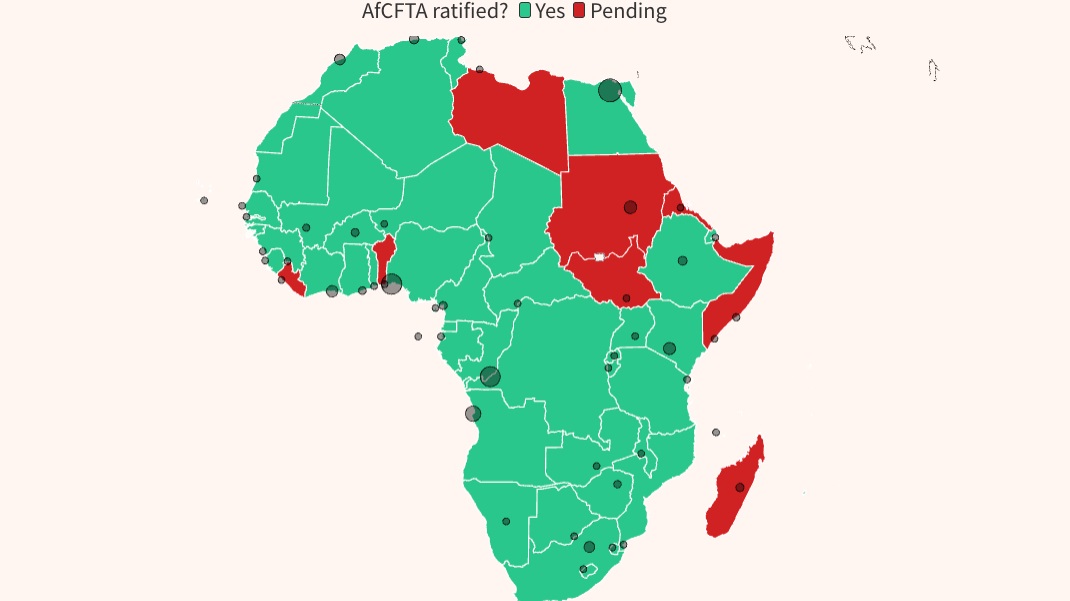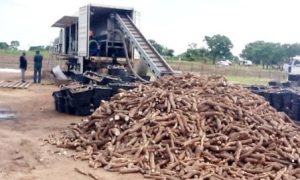Last week marked five years since the African continental free trade area (AfCFTA) agreement entered into force on May 30, 2019, when 24 countries approved its treaty. While trade officially commenced under the AfCFTA framework only in January 2021, it is being slowly implemented in phases, fDi Intelligence reports.
The ultimate goal to be the world’s largest operating free trade area for a continent of 1.3 billion people is still far away.
Given the complexity and time taken for trade negotiations, the fact 54 out of 55 African Union member countries have agreed to the AfCFTA is commendable. But data on trade between African countries shows the road to the full operations of the AfCFTA, and its benefits like boosting regional integration and FDI in the continent, will be a long and difficult one.
For 11 large African countries with data availability, the value of intra-African trade stood at $85.3bn in 2023, representing just 11.8% of total African trade, down from a 13.2% share in 2019, according to figures from Trade Data Monitor.
Overall, intra-African trade as a share of global trade declined from 14.5% in 2021 to 13.7% in 2022, according to UN figures. Over the same period, the global share of intra-African exports and imports also declined.
The International Trade Centre (ITC), a multilateral UN agency dedicated to support trade-led economic growth in developing countries, tells fDi: “The full impact of the AfCFTA remains to be seen, as African countries have been proceeding cautiously with its implementation.”
A pilot phase of AfCFTA launched in October 2022 for eight countries — Cameroon, Egypt, Ghana, Kenya, Mauritius, Rwanda, Tanzania and Tunisia — and 96 products. But African countries have so far committed to only remove tariffs for 90% of products and these commitments are yet to be adopted into national tariff schedules. Services and digital trade are also still pending.
Amid its slow implementation, there are the five main hurdles that have yet to be cleared to determine the success of the AfCFTA.
1. Countries yet to ratify the agreement
First, so far 47 of 54 signatory countries to the AfCFTA have ratified the agreement. There are seven countries who are yet to agree, also known as non-state parties, which are Benin, Liberia, Libya, Madagascar, Somalia, South Sudan and Sudan. Eritrea is the only African country to have not agreed to the AfCFTA agreement.
“Even with agreements like AfCFTA, we’re still in a situation of perpetual negotiations between more than 50 member states, which requires consensus. At the end of the day, there are more than 50 bilateral economic interests to resolve,” explains Marie Wilke, a director at consultancy Africa Practice, who has previously advised on trade negotiations in southern Africa.
2. Disparities between country capacities to implement and enforce the AfCFTA domestically
Second, different levels of economic development and industry mean some countries have lower capacities to implement and enforce the AfCFTA. Domestic implementation of the AfCFTA is currently only fully operational in fewer than 10 countries, according to ITC. Outstanding negotiations on the rules of origins needed to lift tariffs, which include those for sensitive products like cars and textiles, is another major sticking point.
3. How to integrate multiple sub-regional African economic communities
Another obstacle is the need to harmonise the eight regional economic communities (RECs), which group together African states in different parts of the continent. Dorothy Tembo, deputy executive director of ITC and a former trade negotiator for Zambia, tells fDi that the RECs are viewed as the “building blocks to get into an African continental free trade area”. But the process of harmonising rules between them has proven difficult, with some RECs like the East African Community more mature and integrated than other RECs.
4. A lack of access to finance for trading businesses
The fourth hurdle to AfCFTA is one commonly cited across Africa. Due to greater perceived risk, many African businesses struggle to access finance. The gap in trade finance, where a bank legally guarantees that a seller of goods will receive payments from a buyer, is estimated at $81bn per year, according to BACB, a trade finance bank. Some estimates put Africa’s trade finance gap as high as $120bn per year.
“Every single [African trade] delegation that we speak to has this issue on the table,” says Ms Tembo, who argues that more capital access would improve the ability of businesses to invest in their growth and trade across borders.
5. Inadequate transport and logistics infrastructure
The final main obstacle to the success of AfCFTA is inadequate logistics infrastructure like roads, ports and warehouses, which makes trading in Africa difficult. The World Bank’s 2023 logistics performance index ranks many African countries low on factors such as custom processes, the quality of tracking and tracing of goods and the time taken for international shipments.
Efforts to boost intra-Africa trade through AfCFTA are “only as good as the logistics, infrastructure and commercial health of [trading] companies”, concludes John Miller, chief economic analyst at Trade Data Monitor. Creating the world’s largest operating free trade area will be many more years in the making.
fDi



























